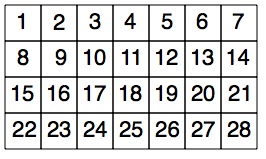Copyright © University of Cambridge. All rights reserved.
Month Mania
When it's the end of January and we need to turn over a page of our calendar, the next page may look a bit like this:
Of course, it probably has a good picture on the page as well, perhaps of a scene from a T.V. show or an animal from your favourite story book.
If we ignore the edge squares which tell you what day of the week it is, then we have a rectangle with twenty eight squares in it like this:-
Well, how about going a bit wild and designing a new shape for these twenty eight squares in which the numbers follow on in some way that is not too difficult to follow? For example, you could put the twenty eight squares into a triangle and decide to go in an up-and-down order like this:-
What other wonderful designs can you come up with?
You can then go further by looking at the way the numbers are arranged and see if you can spot any patterns. For example in the first usual way:-
you may notice things like:
1. If you take any two by two square (like the one in at the top left-hand corner with $1$, $2$, $8$ and $9$ in it), then the opposite corners of that square add up to $10$. Then, if you take the next two by two square along [with $3$, $4$, $10$ and $11$ in] then the opposite corners add up to $14$ and so on.
2. Going down any column the numbers increase by $7$.
Do let us know what you discover in the designs you have created. Can you explain why the patterns occur?
Then ask "I wonder what would happen if ...?''
Why do this problem?
This activity is useful for helping learners to identify and explain number patterns. It is one that can help the more reluctant see that numbers and mathematics can be absorbing. It also has strong design and art links.
Possible approach
You could start by showing the group some examples of various styles of calendars and encourage them to talk about the ways the months are laid out. Then show the class the picture of the calendar in the problem and invite them to talk in pairs about any number patterns they see in it. Can they offer any explanations? Next, show the second arrangement of the twenty eight squares. What number
patterns can they see now?
You could then give them all a piece of $1$ cm squared paper and suggest they explore different arrangements of the twenty eight squares with the numbers arranged in some logical order. In the same way, they can look for any patterns of numbers that appear. If they work in pairs they will be able to talk through their ideas with a partner.
At the end of the lesson the group should come together again to show their various designs and discuss the number patterns they have found. Are there number patterns that keep on appearing? Are there some that have only been found once? Can they suggest why this should be? Can they explain why the patterns occur in each case?
Key questions
How else could you arrange the squares?
How will you write in the sequence of numbers?
Can you explain why this pattern of numbers occurs?
Possible extension
Learners could move on from the calendar situation and arrange other numbers of squares in an interesting way. They could be asked "What would be a good new number to try?" and "Why?".
Possible support
The help needed will depend on whether the learner is finding the numbers or alternative arrangements of the squares difficult. You could suggest arranging the numbers in the original calendar rectangle starting in different corners before trying other arrangements of the squares.



